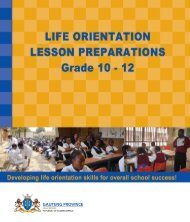Life Science Grade 11
Life Science Grade 11
Life Science Grade 11
Create successful ePaper yourself
Turn your PDF publications into a flip-book with our unique Google optimized e-Paper software.
<strong>Grade</strong> <strong>11</strong> <strong>Life</strong> <strong>Science</strong>s Lesson PlansGRADE <strong>11</strong> SUBJECT <strong>Life</strong> <strong>Science</strong>s WEEK Week 2 TOPIC Fungi - General structure(Rhizopus) LESSON 2LESSON SUMMARY FOR: DATE STARTED:LESSON OBJECTIVESDATE COMPLETED:Content:• Fungi may be classified into three groups: sporangium (produce spores in spore cases called sporangia), club (spores produced in club-shapedstructures) and sac (spores produced in sac-like structures)• Rhizopus is an example of bread mould that grows best in warm, dark places• It is a thallus with no true roots, stems or leaves• It is made up of an entangled mass of filaments called hyphae, that together from a mycelium• The three types of hyphae are rhizoids, stolons and sporangiophores• The bread mould does not have strengthening or conducting tissuesThe learner must be able to:• Describe the structure of the fungus.• Differentiate between the three types of hyphae, rhizoids, stolons and sporangiophores• Draw and label a diagram of the structure of bread mould.TEACHER ACTIVITIES LEARNER ACTIVITIES TIMING RESOURCES NEEDED1.1 Introduction• Pre – knowledge: types of strengthening and conducting tissue in plants• Revise the function of strengthening and conducting tissue found in plants (roots,stems and leaves).• Revise the function of chlorophyll in plants and discuss how organisms that areunable to obtain food through photosynthesis must obtain food.2.2 Main Body (Lesson presentation)• The following must be highlighted by use of blackboard/transparencies andclass discussion:• Fungi show many different structures and characteristics• Fungi are similar to plants in that they have cell walls• Fungi are different to plants since they have no chlorophyll and cannotphotosynthesise (considered heterotrophic)• Fungi may depend on other living organisms as a parasite (such as athlete’sfoot) or may live of dead remains of plants or animals such as bread mould ormushrooms (saprophytes)• Some fungi may be multicellular or unicellular (yeast)10 min15 min• Internet reference (video on structure offungi)http://www.youtube.com/watch?v=dM_g_p4h6CM&feature=related• Website images:http://www.backyardnature.net/f/bredmold.htm (image of bread mould and diagramwith labels)• Solutions for all <strong>Life</strong> <strong>Science</strong>s <strong>Grade</strong> <strong>11</strong> pp.<strong>11</strong>- 12• Oxford Successful <strong>Life</strong> <strong>Science</strong>s <strong>Grade</strong> <strong>11</strong>pp. 18Term 1 Page <strong>11</strong>© Gauteng Department of Education (CAPS version)







